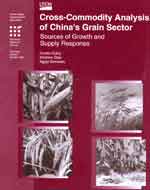Cross-Commodity Analysis of China's Grain Sector: Sources of Growth and Supply Response
- by Xinshen Diao and Agapi Somwaru
- 6/12/2000
Overview
We investigate sources of output growth and supply response in rice, wheat, corn, and soybeans, the four most important crops in China's grain sector, during 1978-97. Using a growth accounting methodology, we found large total factor productivity (TFP) contributions to growth in grain production immediately following China's rural economic reform (1978-85). In 1995-97, the TFP contribution dropped to only 16 percent of growth in grain production, as greater use of inputs increasingly drove growth. In the supply response analysis, the results of the econometrically estimated restricted profit function confirm a joint and nonseparable multiproduct technology for China's grain sector. Complementarity prevails in the grain sector among different outputs and inputs, meaning that an increase in the price of intermediate inputs/capital or wages would result not only in an absolute reduction in all outputs but also in a change in the composition of these outputs. The expansion (or scale) effects subsided during 1986-97, implying a relatively slow outward shift of the production frontier during this period. If the current government policy environment remains unchanged, China's grain production will become more costly, constraining its future growth and competitiveness in world markets.
Download
-
Entire report
Download PDF

